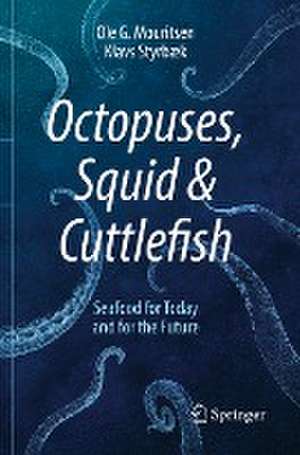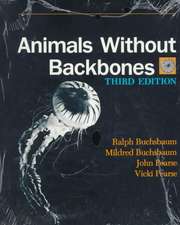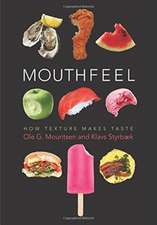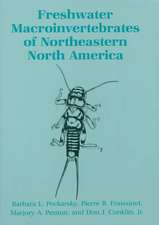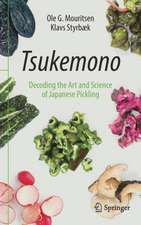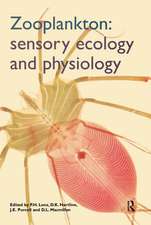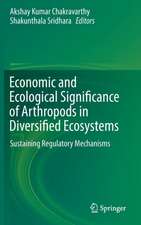Octopuses, Squid & Cuttlefish: Seafood for Today and for the Future
Autor Ole G. Mouritsen, Klavs Styrbæken Limba Engleză Paperback – 7 mai 2022
Although they are soft-bodied and look vulnerable, cephalopods are formidable predators. Octopuses have arms that are so strong that they can exert a force equal to hundreds of times their own body weight. Squid and cuttlefish can shoot out a tentacle to capture prey at the speed of a javelin thrown by an expert athlete.
Cephalopods are, however, so much more than just fascinating creatures with strange physical characteristics. They are a nutritious, delicious protein source that has found a place for thousands of years in many food cultures around the world. As squid, cuttlefish, and octopuses are native to virtually all parts of the ocean, they are an excellent and available alternative to meat from terrestrial animals.
This book is written to promote the overall place of cephalopods in home kitchens and to inspire the uninitiated to add them to their diet. It describes the many facets of their anatomy that play a central role in their potential use as healthy, diverse,and interesting food sources, with a particular emphasis on their taste and texture. By way of an assortment of recipes, the authors hope to dispel the myth that it is difficult to prepare delicious dishes using squid, cuttlefish, and octopuses. In addition, there are contributions to the on-going discussions about how marine resources can be exploited more responsibly in a sustainable manner.
Ole G. Mouritsen is a professor of gastrophysics and culinary food innovation at the University of Copenhagen,president of the Danish Gastronomical Academy, and director of the Danish national research and communication centre Taste for Life.
Klavs Styrbæk is a chef and leader of the gastronomic enterprise STYRBÆKS, which includes a gourmet restaurant, a cooking school, a catering service, and a product development branch.
| Toate formatele și edițiile | Preț | Express |
|---|---|---|
| Paperback (1) | 186.95 lei 3-5 săpt. | +29.90 lei 7-13 zile |
| Springer International Publishing – 7 mai 2022 | 186.95 lei 3-5 săpt. | +29.90 lei 7-13 zile |
| Hardback (1) | 195.53 lei 3-5 săpt. | +31.23 lei 7-13 zile |
| Springer International Publishing – 6 mai 2021 | 195.53 lei 3-5 săpt. | +31.23 lei 7-13 zile |
Preț: 186.95 lei
Nou
Puncte Express: 280
Preț estimativ în valută:
35.77€ • 38.98$ • 30.14£
35.77€ • 38.98$ • 30.14£
Carte disponibilă
Livrare economică 02-16 aprilie
Livrare express 19-25 martie pentru 39.89 lei
Preluare comenzi: 021 569.72.76
Specificații
ISBN-13: 9783030580292
ISBN-10: 3030580296
Pagini: 278
Ilustrații: XIV, 278 p. 120 illus., 115 illus. in color.
Dimensiuni: 155 x 235 x 21 mm
Greutate: 0.41 kg
Ediția:1st ed. 2021
Editura: Springer International Publishing
Colecția Springer
Locul publicării:Cham, Switzerland
ISBN-10: 3030580296
Pagini: 278
Ilustrații: XIV, 278 p. 120 illus., 115 illus. in color.
Dimensiuni: 155 x 235 x 21 mm
Greutate: 0.41 kg
Ediția:1st ed. 2021
Editura: Springer International Publishing
Colecția Springer
Locul publicării:Cham, Switzerland
Cuprins
Introduction.- Part I. Strange beings from the depths of the sea., Mythological sea monsters.- Cephalopods in art, literature, and iconography.- And they continue to fascinate us.- Part II. Such abundance, so much diversity.- A few words about their classification.- Head-feet’ that have no feet.- When did the cephalopods appear on the scene?.- Where and how do they live?.- Part III. An overview of cephalopod anatomy.- The mantle.- Heart, nerves, and intelligence.-Consciousness of another kind.- Eyes.- Mouth and beak.- Arms and tentacles.- Suckers, which have a sense of taste.- Blue blood and three hearts.- Muscles.- Siphon.- Ink., Innards.- A master of disguises., Luminescence.- Skin as a sense receptor.- Octopuses in Naples.- Part IV. Cephalopod fisheries.- The global catch.- Harvesting cephalopods in the Mediterranean., Part V. Taste and nutritional value., Nutrients in cephalopods.- How do they taste?.- Are marine-borne toxins a problem?.- Part VI. Sourcing, storing, and preparing cephalopods.-Where to purchase cephalopods.- How to clean and store them.-Making them tender.- Fermenting cephalopods and using them as fermentation agents.- Cooking with their ink.- Part VII. Cephalopods in the kitchen.- In culinary traditions around the world.- Raw or almost raw.- Eating the perfect cuttlefish sashimi in London.- Shopping for octopus and cuttlefish at an Italian street market.- Marinating cephalopods.- Dehydrated cephalopods.- Octopus stock and the ‘foie gras of the sea’.- Grilled cephalopods.- Deep-fried cephalopods.-Pescaito frito made with squids.- The evolution of pescado frito.-Steamed and cooked cephalopods.- Cooking them in a wok.- Stuffed cephalopods.- Using the ink in dishes and snacks.- A take on The Compleat Angler using giant squid.- Cephalopods in Vietnam and Cambodia.- Part VIII. The Nordic Food Lab’s “Squid Squad”.- The Nordic Food Lab, gastronomy, and gastrophysics.- Squids of the North.- A surprising discovery.- Featuring cephalopods at Taste for Life.- A marine ‘field trip’ to Sardinia with an expert chef.- Part IX. The seafood of the future?.- Food from the oceans for a hungry planet.- Is cephalopod aquaculture an option?.- Discovering the life cycle of the cuttlefish in Brittany.- Like ‘weeds of the sea,’ the cephalopods are multiplying.- Eat the cephalopods!.- Part X. Technical and scientific details.- The genealogy of cephalopods.- List of cephalopods mentioned in this book.- Glossary.- Culinary terms.- Bibliography.-Illustrations.- Acknowledgements.- The people behind the book.-Recipes.- Cleaning and storing cephalopods.- Iko no shiokara.-Cuttlefish in their own ink (calamari en su tinto).- Ika sashimi with avocado and lumpfish roe.- Squid ink fettucine with lobster, roe, and dried lime.- Sepia tartare with pistachios, lime, and avocado.- Squid royale with Jerusalem artichokes in sepia ink.- Octopus salad.-Peruvian squid ceviche.- Grilled, partially dehydrated squids (ikano ichiya-boshi).- Glazed octopus arms with lentils and mushrooms.- ‘Foie gras of the sea’.- Grilled or seared cuttlefish.- Marinated grilled cuttlefish siphons on lemongrass.- Cephalopod mouths and beaks in white beans with tomatoes and dried shrimp.- Fried calamari with octopus chips and mayonnaise., Extra crisp squid rings and strips., Pulpo à la Gallego.- Calamar à la mar del Norte.- Cooked squid with spinach, roe, and cream sauce.- Salt and pepper wok-fried squid., Squid ‘cobs’ with snow peas.- Stuffed squids.- ‘Santa hats’—squids baked in piquillo peppers with capers.- Black potato gnocchi with squids.- Black pasta with squids.- Black hot dog buns with seaweed onion jam.- Crisp spaghetti with soy-roasted pumpkin seeds.- Pasta fritta with cuttlefish ink.- Sweet azuki beans in cuttlefish ink.- Giant squid, roasted in the manner of The Compleat Angler.- Japanese flying squids at their best.- Cambodian squid curry., Kroeung spice mixture for Kmer amokSilky squid confit.- Black saucemade from squid ink and squid livers.- Sardinian-inspired squid biscuits.
Notă biografică
Ole G. Mouritsen is a research scientist and professor of gastrophysics and culinary food innovation at Copenhagen University. His work focuses on basic sciences and their applications within the fields of biotechnology, biomedicine, and food. He is the recipient of numerous prizes for his work and for research communication. His extensive list of publications includes a number of monographs, several of them co-authored with Klavs Styrbæk, which integrate scientific insights with culinary perspectives and have been nominated three times for Gourmand Best in the World Awards. Currently, Ole is president of The Danish Gastronomical Academy and director of the National Danish Taste Centre Taste for Life, which is generously supported by the Nordea Foundation. This is a cross-disciplinary centre that aims to foster a better understanding of the fundamental nature of taste impressions and how we can use this knowledge to make much more informed and healthier food choices. Its extensive educational program reaches out to audiences of all ages, with a special effort directed toward children to shape their dietary habits from an early age. For many years, Ole has been fascinated with the Japanese culinary arts and in explaining the extent to which its techniques and taste elements can be adapted for the Western kitchen. In recognition of his efforts, he was appointed in 2016 as a Japanese Cuisine Goodwill Ambassador by the Japanese Ministry of Agriculture, Forestry, and Fisheries, and in 2017 the Japanese Emperor bestowed upon him The Order of the Rising Sun, Gold Rays With Neck Ribbon, Kyokujitsuchujusho旭日中綬.
Klavs Styrbæk is a professional chef who owns and operates STYRBÆKS together with his wife, Pia. By combining a high standard of craftsmanship, sparked by curiosity-driven enthusiasm, he has created a gourmet centre where people can enjoy excellent food and where they can come to learn and take their culinary skills to a whole new level. Klavs is particularly enthusiastic about seeking out unique, local raw ingredients that are incorporated into new taste adventures or used to revisit traditional Danish recipes that might otherwise be forgotten. This delicate balance between innovation and renewal is demonstrated in his award-winning cookbook Mormors mad (Grandmother’s Food) (2006), which was honored with a special jury prize at the Gourmand World Cookbook Awards in 2007. In 2008 and 2019 he was awarded an honorary diploma for excellence in the culinary arts by the Danish Gastronomical Academy. Many of the recipes that appear in the books co-authored with Ole originated in the test-kitchens at STYRBÆKS.
Jonas Drotner Mouritsen is a graphic designer and owner of the design company Chromascope that specializes in graphic design, animation, and film production. His movie projects have won several international awards. In addition, he has been responsible for layout, photography, and design of several books about food, some of which have been nominated for Gourmand World Cookbook Awards.
Mariela Johansen, who has Danish roots, lives in Vancouver, Canada, and holds an MA in Humanities with a special interest in the ancient world. Working with Ole and Klavs, she has translated several monographs, adapting them for a wider English language readership. Two of these, Umami: unlocking the secrets of the fifth taste and Mouthfeel: How Texture Makes Taste, won a Gourmand World Cookbook Award for the best translation of a cookbook published in the USA in 2014 and 2017, respectively.
Klavs Styrbæk is a professional chef who owns and operates STYRBÆKS together with his wife, Pia. By combining a high standard of craftsmanship, sparked by curiosity-driven enthusiasm, he has created a gourmet centre where people can enjoy excellent food and where they can come to learn and take their culinary skills to a whole new level. Klavs is particularly enthusiastic about seeking out unique, local raw ingredients that are incorporated into new taste adventures or used to revisit traditional Danish recipes that might otherwise be forgotten. This delicate balance between innovation and renewal is demonstrated in his award-winning cookbook Mormors mad (Grandmother’s Food) (2006), which was honored with a special jury prize at the Gourmand World Cookbook Awards in 2007. In 2008 and 2019 he was awarded an honorary diploma for excellence in the culinary arts by the Danish Gastronomical Academy. Many of the recipes that appear in the books co-authored with Ole originated in the test-kitchens at STYRBÆKS.
Jonas Drotner Mouritsen is a graphic designer and owner of the design company Chromascope that specializes in graphic design, animation, and film production. His movie projects have won several international awards. In addition, he has been responsible for layout, photography, and design of several books about food, some of which have been nominated for Gourmand World Cookbook Awards.
Mariela Johansen, who has Danish roots, lives in Vancouver, Canada, and holds an MA in Humanities with a special interest in the ancient world. Working with Ole and Klavs, she has translated several monographs, adapting them for a wider English language readership. Two of these, Umami: unlocking the secrets of the fifth taste and Mouthfeel: How Texture Makes Taste, won a Gourmand World Cookbook Award for the best translation of a cookbook published in the USA in 2014 and 2017, respectively.
Textul de pe ultima copertă
Humans everywhere have always been fascinated by octopuses, squid, and cuttlefish, known biologically as cephalopods. They evolved hundreds of millions of years ago and are related to molluscs such as mussels and snails. They can grow to an enormous size with eyes as big as footballs, but they still live for only a couple of years. They mate once in their lifetime and die shortly after. They have blue blood and three hearts and they can shoot out jet-black ink. They have a brain and have behaviours that could be interpreted as signs of intelligence, even though more than half of their brain is distributed in their arms. They are colour blind, but they can change the colour of their skin in a flash. They are masters of disguise and are able to alter the texture of their skin and the patterns displayed on it at lighting speed. They can also ‘taste’ using the suckers on their arms. They can move extremely fast thanks to a jet-propulsion system built into their body cavity.
Although they are soft-bodied and look vulnerable, cephalopods are formidable predators. Octopuses have arms that are so strong that they can exert a force equal to hundreds of times their own body weight. Squid and cuttlefish can shoot out a tentacle to capture prey at the speed of a javelin thrown by an expert athlete.
Cephalopods are, however, so much more than just fascinating creatures with strange physical characteristics. They are a nutritious, delicious protein source that has found a place for thousands of years in many food cultures around the world. As squid, cuttlefish, and octopuses are native to virtually all parts of the ocean, they are an excellent and available alternative to meat from terrestrial animals.
This book is written to promote the overall place of cephalopods in home kitchens and to inspire the uninitiated to add them to their diet. It describes the many facets of their anatomy that play a central role in their potential use ashealthy, diverse, and interesting food sources, with a particular emphasis on their taste and texture. By way of an assortment of recipes, the authors hope to dispel the myth that it is difficult to prepare delicious dishes using squid, cuttlefish, and octopuses. In addition, there are contributions to the on-going discussions about how marine resources can be exploited more responsibly in a sustainable manner.
Ole G. Mouritsen is a professor of gastrophysics and culinary food innovation at the University of Copenhagen,president of the Danish Gastronomical Academy, and director of the Danish national research and communication centre Taste for Life.
Klavs Styrbæk is a chef and leader of the gastronomic enterprise STYRBÆKS, which includes a gourmet restaurant, a cooking school, a catering service, and a product development branch.
Although they are soft-bodied and look vulnerable, cephalopods are formidable predators. Octopuses have arms that are so strong that they can exert a force equal to hundreds of times their own body weight. Squid and cuttlefish can shoot out a tentacle to capture prey at the speed of a javelin thrown by an expert athlete.
Cephalopods are, however, so much more than just fascinating creatures with strange physical characteristics. They are a nutritious, delicious protein source that has found a place for thousands of years in many food cultures around the world. As squid, cuttlefish, and octopuses are native to virtually all parts of the ocean, they are an excellent and available alternative to meat from terrestrial animals.
This book is written to promote the overall place of cephalopods in home kitchens and to inspire the uninitiated to add them to their diet. It describes the many facets of their anatomy that play a central role in their potential use ashealthy, diverse, and interesting food sources, with a particular emphasis on their taste and texture. By way of an assortment of recipes, the authors hope to dispel the myth that it is difficult to prepare delicious dishes using squid, cuttlefish, and octopuses. In addition, there are contributions to the on-going discussions about how marine resources can be exploited more responsibly in a sustainable manner.
Ole G. Mouritsen is a professor of gastrophysics and culinary food innovation at the University of Copenhagen,president of the Danish Gastronomical Academy, and director of the Danish national research and communication centre Taste for Life.
Klavs Styrbæk is a chef and leader of the gastronomic enterprise STYRBÆKS, which includes a gourmet restaurant, a cooking school, a catering service, and a product development branch.
Caracteristici
Presents cephalopods in the combined context of cultural history, biology, animal behavior, food resources, sustainability, gastroscience, gastronomy, and cooking Explores the many possibilities for cooking with octopuses, squid, and cuttlefish—arms, heads, innards, ink, and all Discusses how cephalopods might come to feature more prominently in, and make up a greater proportion of, the food that we will be eating in the future
